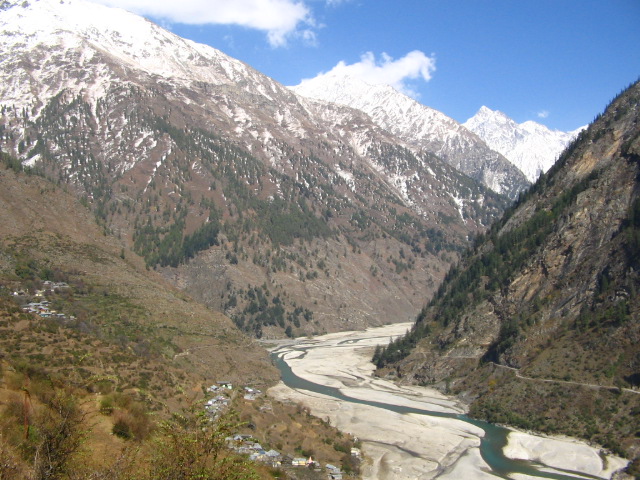 The Bhagirathi in its upper reaches, here seen near Dharali (Photo: Chicu Lokgariwar)
The Bhagirathi in its upper reaches, here seen near Dharali (Photo: Chicu Lokgariwar)
The report is divided into the following sections
- Preamble
- Objective of the study
- Methodology
- Observations on rivers and Tehri reservoir
- Self preservation capacity of river Bhagirathi, Ganga
- Emission of green house gases from Tehri reservoir
- Summary of experimental results
- Conclusion
1. Preamble
This section begins with a description of the Bhagirathi from its emergence at Gomukh. The Tehri dam, including its history, catchment area, storage and construction are then described.
The rithron zone of a river is that in the upper mountainous reaches. The potamon, on the other hand exhibits slow flow, sandy or muddy bed and warm temperatures. The Bhagirathi in its entire stretch can be categorized as rithron. This is further divided into three sub-zones: Epi-rithron, Meth-rithron, and Hypo-rithron. The section goes on to mention the self-purification properties of the Ganga, and defines it as ' the elimination of dissolved as well as particulate matter of polluting properties.
2. Objective of the study
The study aimed to determine abiotic and biotic characteristics of the Bhagirathi, evaluate its self-purification capacity, and ultimately, determine if the impact of Tehri dam and reservoir on these properties.
3. Methodology
This study draws upon information gathered from 14 sampling points from Gomukh to Rishikesh, ten sampling points in the reservoir, and a study carried out between 2002-04 prior to the construction of the dam. A list of these sampling points is attached in the study.
4. Observations on rivers and Tehri reservoir
A comprehensive list of water quality parameters is included in this section.
Several data tables giving the physico chemical characteristics at the various sampling stations, and for different seasons follow. These results are then summarized , with a focus on comparing the values for the Bhagirathi and the reservoir.
- DO: river: 5.3-16.8, reservoir: 5.16-10.7
- pH: river: 6-8.07, reservoir: 6.2-8.6
- Turbidity: river 1-6.5 NTU, reservoir: 0.9-6.6 NTU
- Ammonia: river: 0.1 to 2 mg/l, reservoir: 0.49 to 2.2 mg/l
- Phosphorous: river: 0.02 to 5.6, reservoir: 0.02 to 4.5
- Total nitrogen: river: 0.6 to 4.0 mg/l, reservoir: 0.8 to 4.6 mg/l
Concentrations of metals are also given in this report.
The water samples collected were also analysed for total coliforms, faecal coliforms, e-coli and faecal streptococci. The results show that as expected, faecal contamination increases as we move downstream, with the increase in settlements.
The water quality index was applied to compare the water quality between different stretches of the Bhagirath and Tehri reservoir.
Coliphages were concentrated from large volumes of water for detection using the modified bituminous coal method, which is detailed in the report. 32 different varieties of hosts were used for their detection. The status of biota in the river waters of the Bhagirathi, Alaknanda, and Mandakini were evaluated, and the results presented in the report, with application of the Shannon Wiener Diversity Index. Similarly, Palmers index was applied to the algae at the sampling stations.
The reports assert that the water quality of the Bhagirathi is influenced considerably by the sediment it carries. The metal concentration in the sediment is much higher than the crustal average. The mineral composition of the sediments and their bacteriological quality, including the presence of coliphages are presented in detail in the report.
A study of the radioactive isotopes indicates a significant difference in the radium isotope presence in highland rivers (which are enriched in Ra226) and the lowland rivers (enriched in Ra228). The report also quotes a study that states that short-lived isotopes are present in higher concentration in the Ganga as compared to other rivers. They speculate that this high concentration may contribute to the bactericidal properties of the Ganga.
5. Self preservation capacity of river Bhagirathi, Ganga
Among believers, the waters of the Ganga are said to possess a capacity to purify itself. The paper discusses various factors that contribute to this. The first bacteriophages were discovered in 1915 in the waters of the Ganga. The sediments of the river are also more radioactive than others.
The paper concludes that suspended particles are responsible for this self preservation capacity. For this reason, it is necessary to allow some continuous flow through the dam that will allow for the transportation of sediment downstream.
6. Emission of greenhouse gases from Tehri reservoir
Gas samples were collected from 64 locations in the reservoir, in September 2008 and May 2009. The emission levels of carbon dioxide and methane were 2550 and 24 mg/sqm respectively, which is considerably lower than those of other tropical reservoirs.
7. Summary of experimental results
The maximum and minimum values for the various parameters described above are listed in this section.
8. Conclusions
After the studies, the report concludes that the water of the Bhagirathi owes its special powers to its radioactive sediment content, and to the coliphages. It then concludes that the Tehri dam does not affect this property of the Ganga. The paper however, does acknowledge that it is necessary to have a certain level of suspended solid downstream of Tehri.
The annexures of this report have information on drinking water standards, and microbiological and biological quality.













